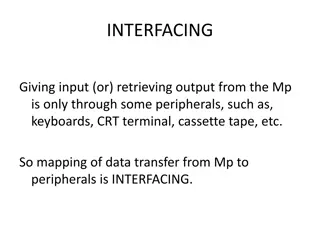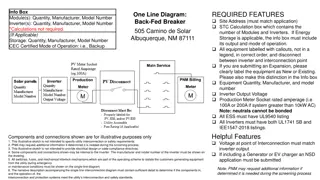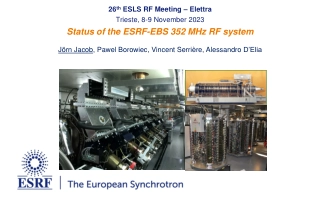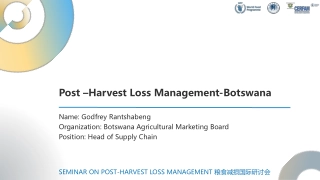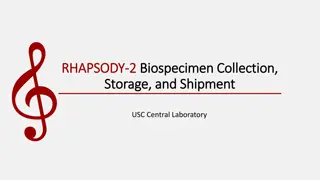SnapStore: Snapshot Storage System for Serverless Systems
SnapStore is a snapshot storage system designed to minimize the cost of fetching snapshots in serverless systems. It focuses on efficient storage of function snapshots, utilizing techniques like cold start mitigation and deduplication to optimize resource utilization and streamline the restoration process. The system aims to enhance the overall performance and scalability of serverless environments.
Download Presentation
Please find below an Image/Link to download the presentation.
The content on the website is provided AS IS for your information and personal use only. It may not be sold, licensed, or shared on other websites without obtaining consent from the author. Download presentation by click this link. If you encounter any issues during the download, it is possible that the publisher has removed the file from their server.
Presentation Transcript
1 SNAPSTORE: ASNAPSHOT STORAGESYSTEMFORSERVERLESS SYSTEMS Abhisek Panda, Smruti R. Sarangi Computer Science and Engineering IIT Delhi, India 24th ACM/IFIP International Middleware Conference
2 OUTLINE Problem Statement Problem Statement Motivation and Prior Work Design of SnapStore Results Conclusion
3 COLD START MITIGATION Cost of spawning a sanbox environment. F2 F2 F3 F3 F1 F1 F2 F1 F3 DRAM Remote Storage Service Function Snapshot F3 F2 F1 Minimizes the initialization cost. Sandbox Environment Disk
4 PROBLEM STATEMENT Goal: Design an efficient snapshot storage system capable of storing an ample amount of function snapshots. F1 F1 F1 DRAM Remote Storage Service The benefits of snapshot and restore techniques are limited by the cost of fetching the snapshot. F2 F3 Disk
5 OUTLINE Problem Statement Motivation and Prior Work Motivation and Prior Work Design of SnapStore Results Conclusion
6 SNAPSHOT ANALYSIS F1 Memory File 55.6% RX_ MAP26.9% W_M AP 51.6% 21.5% NRT A runtime page without write permission (RX_MAP) A runtime page with write permission (W_MAP) A dirty A non-dirty memory page A non-runtime memory page (NRT) memory page
7 SCOPE OF DEDUPLICATION F1 F2 Region Type Data redundancy b/w regions 56.7% - 77.5% 57.4% - 94.6% Up to 25.2% Impact on redundancy with a decrease in the data chunk s size Increases Remains almost the same Increases NRT RX_MAP W_MAP NRT RX_MAP W_MAP
8 PRIOR WORK VM Deduplication (QuickDedup(JPDC 20)) Does not exploit the deduplication opportunities at a granularity of memory region types. Data Deduplication [MeGA(ATC 22), (HiDeStore (Middleware 20)] Explicitly designed for backup data. Does not take adequate measures to improve the restoration process in the context of microVM snapshots.
9 OUTLINE Problem Statement Motivation and Prior Work Design of SnapStore Design of SnapStore Results Conclusion
10 SNAPSTORE: DEDUPLICATION Split into memory regions F1 Divide a region into chunks and compute their respective hashes. # # # # # # # # ################ Index Table Index Table Fingerprint Fingerprint Detect and eliminate duplicate chunks among regions of the same type Recipe F1 NRT W_MAP RX_MAP Data block store Data block store Data block store
11 SNAPSTORE: RETRIEVAL Restore chunks as per the memory region type. Recipe F1 Data block store Data block store Data block store Restore Cache F1 RAM Based Cache NRT W_MAP RX_MAP
12 OUTLINE Problem Statement Motivation and Prior Work Design of SnapStore Results Results Conclusion
13 SETUP AND STORAGE COST Name Processor CPUs HDD Setting Intel Xeon 6226R 1 Socket, 16 cores Seagate 2TB HDD, 7.2KRPM Samsung 860 EVO 500GB 256 GB 7.5 SSD DRAM GCC version SnapStore reduces the deduplication ratio by 21.6%.
14 DEDUPLICATION TIME Deduplication time on SSDs Deduplication time on HDDs SnapStore improves the deduplication time by 50% on HDDs and 30.8% on SSDs.
15 END-TO-END LATENCY End-to-end latency on HDDs End-to-end latency on SSDs With the integration of SnapStore with FaaSnap (a state-of-the-art serverless platform), the end-to-end latency improves by 25.9% over FaaSnap on HDDs, while it degrades by a mere 0.6% on SSDs, on average.
16 OUTLINE Problem Statement Motivation and Prior Work Design of SnapStore Results Conclusion Conclusion
17 CONCLUSION The occupancy of non-dirty memory pages of a function snapshot is 55.6% of the memory file. The degree of overlap between the memory regions of a memory region type (NRT, RX_MAP, W_MAP) varies, while that of W_MAP is the lowest. SnapStore + FaaSnap improves the end-to-end latency of serverless functions by 25.9% along with 2.4 storage space reduction over vanilla FaaSnap on HDDs.
18 Thank You Contact: Abhisek Panda: abhisek.panda@cse.iitd.ac.in Smruti R. Sarangi: srsarangi@cse.iitd.ac.in
































